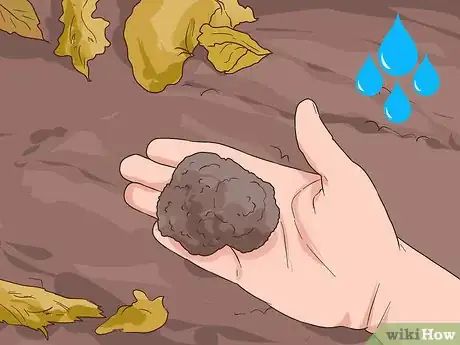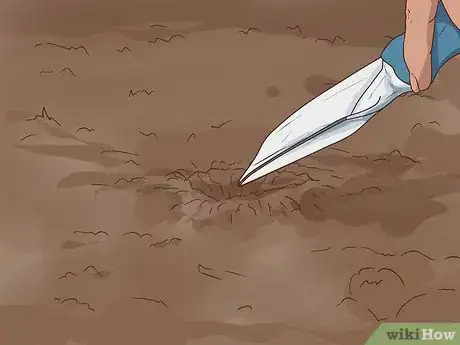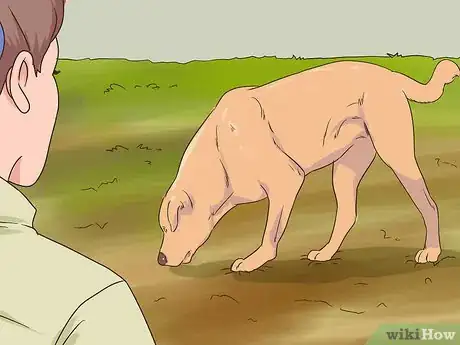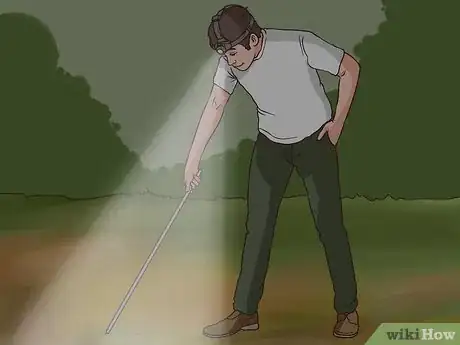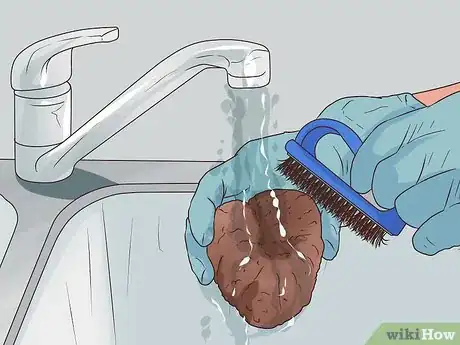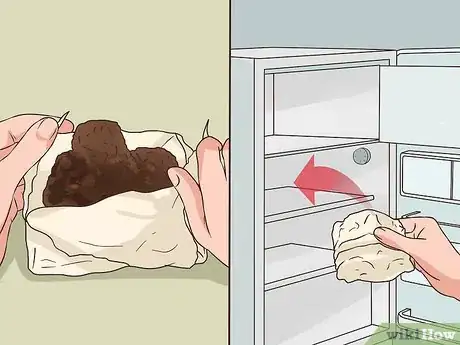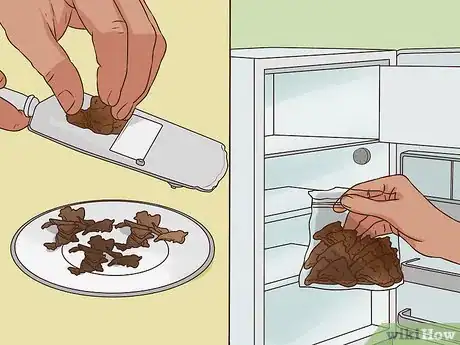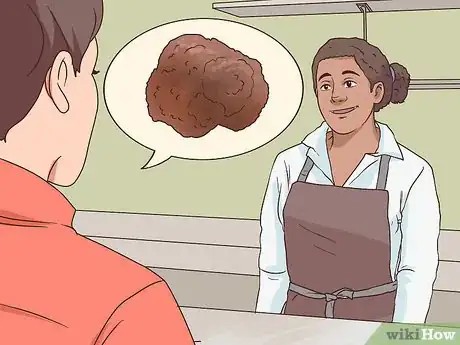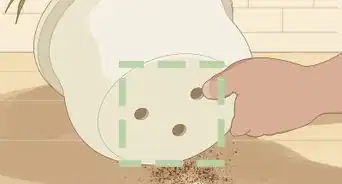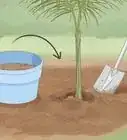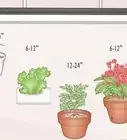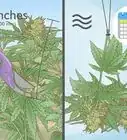This article was co-authored by wikiHow Staff. Our trained team of editors and researchers validate articles for accuracy and comprehensiveness. wikiHow's Content Management Team carefully monitors the work from our editorial staff to ensure that each article is backed by trusted research and meets our high quality standards.
There are 11 references cited in this article, which can be found at the bottom of the page.
This article has been viewed 144,527 times.
Learn more...
Truffles are rare, edible fungi that grow underground and have a distinct smell and taste that’s highly desired in the culinary world. Truffles are difficult to find and even more difficult to grow, so many chefs will pay a pretty penny for them.[1] If you’re a chef in need of some fantastic flavor or someone who just likes the idea of making some good money, search for truffles in all of the likely places. Use helpful tools to give yourself an advantage and clean, store, and sell your truffles once you’ve found them.
Steps
Looking in Good Places
-
1Go to western Europe or the Pacific Northwest. Truffles are hard to find. While you may be lucky enough to find a few in other areas, you’ll up your chances greatly by looking in countries in western Europe and U.S. states in the Pacific Northwest. More specifically, search through forests located in Italy, France, Oregon, and Washington.[2]
-
2Search where the soil is moist. Truffles thrive in moist soil, so search where the ground is often damp and/or spend the most time looking just after there’s been a lot of rainy weather. For the best results, search 10-14 days after a heavy rainfall has taken place.[3]Advertisement
-
3Search near beech, fir, and oak trees. Trees that form ectomycorrhizal relationships with fungi, such as beech, fir, and oak trees, must be present in order for truffles to grow, because truffles attach to tree roots. Search for truffles around the bases of these types of trees.[4]
-
4Look for browning dirt around the base of trees. Instead of wasting your time digging around every tree that could possibly have truffles growing on its roots, look carefully at the ground to see if there are any signs of fungus. If truffles are present, a “browning” effect called “brûlée” will make the ground look burnt, rough, and darker than surrounding areas because their existence prevents vegetation from growing.[5]
-
5Search for small holes in the dirt. Look very carefully at the “brûlée” areas for small holes. This is a sign that rodents have been digging in the area to look for food. Seeing a lot of these may mean that rodents smelled the truffles’ strong aroma and began digging to find and eat them.[6]
-
6Identify truffles by their resemblance to small potatoes. There are thousands of different types of truffles, most commonly black, white, or burgundy in color. When ripe and ready to eat, they’re typically between the size of a marble and the size of a golf ball. While their appearance varies, many of them seem to resemble small potatoes, so keep this in mind as you’re searching.[7]
Using Beneficial Tools
-
1Train a dog to help you. One of the biggest advantages you can give yourself is recruiting a dog’s help. Dogs are a major asset to the search process because they can only smell ripe truffles, so they won’t dig up worthless, inedible truffles. Additionally, they can be trained fairly easily and can be taught to not eat the truffles when they find them.[8]
- If you want to train your dog to hunt truffles in the northwestern United States, there are many trainers that offer these specific services. Some of these trainers include NW Truffle Dogs (Portland, OR), Trifecta Training (Eugene, OR), and Toil and Truffle (Seattle, WA).[9]
- Pigs are also good at finding truffles, but they’re much more difficult to train and they often eat the truffles.[10]
-
2Dig truffles up with a rake. When you’ve found an area beneath a tree that you think may contain truffles, use a small 4-prong rake to dig up the dirt in the area.[11] If truffles are present, they’re likely 1 to 6 inches (2.5 to 15.2 cm) deep in the soil. However, sometimes they can be located as deep as 1 foot (0.30 m) underground or show up above ground.[12]
-
3Use headlamps for night time searches. In some of the more popular searching areas, within Italy, for example, people dig all day every day hoping to strike it rich. If you want to search in one of these areas, consider searching during the night so that no one will be in your way. Simply put on an LED headlamp and get digging.[13]
Cleaning, Storing and Selling Your Truffles
-
1Clean off dirt with water and a nail brush. After you’ve collected some truffles, bring them to a sink and start running some cold water. Hold the truffles underneath the water and use a nail brush or toothbrush to carefully remove any dirt that’s on the outside of the truffles.[14]
-
2Store your truffles in paper in the refrigerator. Wrap your clean truffles in kitchen paper or put them in a brown paper bag and roll the bag up tight. Keep your truffles fresh by storing them this way in your refrigerator for up to 10 days.[15]
- Don’t wrap your truffles in plastic.
-
3Store your truffles in the freezer long-term. If you’re hoping to preserve your truffles for longer than about 10 days, consider storing them in the freezer. You can either put them in a plastic bag, squeeze all of the air out, and then seal them well, or you can grate the truffles, mix them in with butter, and freeze the butter. Either way, the truffles will stay good for up to 6 months if kept frozen.[16]
- When you’re ready to cook and eat the truffles, it’s best to start cooking them while they’re still frozen, instead of thawing them out first.
-
4Sell your truffles to upscale restaurants. Truffles are scarce and difficult to find on a consistent basis because they aren’t grown commercially. Truffles are a popular culinary delicacy that is highly demanded and desired in expensive, upscale restaurants. Immediately after you find truffles, email and/or call the upscale restaurants in nearby cities to see if the chefs of these restaurants are interested in purchasing yours.[17]
Community Q&A
-
QuestionCan I find truffles in Northern Texas?
 ChrisTop AnswererYes, a variety of truffle known as the pecan truffle can be found in parts of the southern United States, including Texas. These mushrooms are known to grow at the base of pecan trees, hence their name. There are three species of pecan truffle, and all of them taste quite different than the renowned white or black truffle.
ChrisTop AnswererYes, a variety of truffle known as the pecan truffle can be found in parts of the southern United States, including Texas. These mushrooms are known to grow at the base of pecan trees, hence their name. There are three species of pecan truffle, and all of them taste quite different than the renowned white or black truffle. -
QuestionIs it legal for me to search in the woods for truffles?
 ChrisTop AnswererYes, it is perfectly legal in woods, so long as you are not trespassing on private property. It is also illegal to search for truffles in state or national parks.
ChrisTop AnswererYes, it is perfectly legal in woods, so long as you are not trespassing on private property. It is also illegal to search for truffles in state or national parks. -
QuestionWhat kind of dog should I get to help me find truffles?
 LinnieTop AnswererThe lagotto romagnolo is known for being a great truffle-hunting dog. Other breeds that can be trained to find truffles include the springer spaniel, Belgian malinois, poodle, and several hound breeds.
LinnieTop AnswererThe lagotto romagnolo is known for being a great truffle-hunting dog. Other breeds that can be trained to find truffles include the springer spaniel, Belgian malinois, poodle, and several hound breeds.
References
- ↑ https://wonderopolis.org/wonder/what-are-truffles
- ↑ https://www.thrillist.com/eat/nation/things-you-didnt-know-about-truffle-foraging
- ↑ https://www.youtube.com/watch?v=oyXFVCOrOf8&feature=youtu.be&t=40s
- ↑ https://www.youtube.com/watch?v=oyXFVCOrOf8&feature=youtu.be&t=32s
- ↑ https://www.youtube.com/watch?v=oyXFVCOrOf8&feature=youtu.be&t=47s
- ↑ https://www.thrillist.com/eat/nation/things-you-didnt-know-about-truffle-foraging
- ↑ http://www.natruffling.org/faq.htm
- ↑ http://www.cnn.com/2015/02/26/living/domestic-truffles-eatocracy-feat/index.html
- ↑ http://www.natruffling.org/faq.htm
- ↑ http://www.natruffling.org/faq.htm
- ↑ https://www.thrillist.com/eat/nation/things-you-didnt-know-about-truffle-foraging
- ↑ http://www.natruffling.org/faq.htm
- ↑ https://www.nytimes.com/2015/10/18/magazine/how-to-find-truffles.html
- ↑ https://www.theguardian.com/lifeandstyle/2014/dec/13/hunting-truffles-british-woodland-fungi
- ↑ http://www.natruffling.org/faq.htm
- ↑ http://marxfood.com/how-to-store-fresh-truffles/
- ↑ https://munchies.vice.com/en_us/article/jpa3yb/i-sold-culinary-crack-to-michelin-starred-chefs
About This Article
To find truffles, search in western Europe or the Pacific Northwest, which is where they grow. They thrive in moist soil, so it's best to search for them 10-14 days after a heavy rainfall. Look for browning dirt and tiny holes at the bases of beech, fir, and oak trees, then use a rake to dig in locations that look promising. Ripe truffles might be black, white, or burgundy in color and they resemble tiny potatoes. To increase your chances of finding truffles, have your dog trained by a professional to sniff them out. To learn how to clean and store the truffles you find, keep reading the article!

